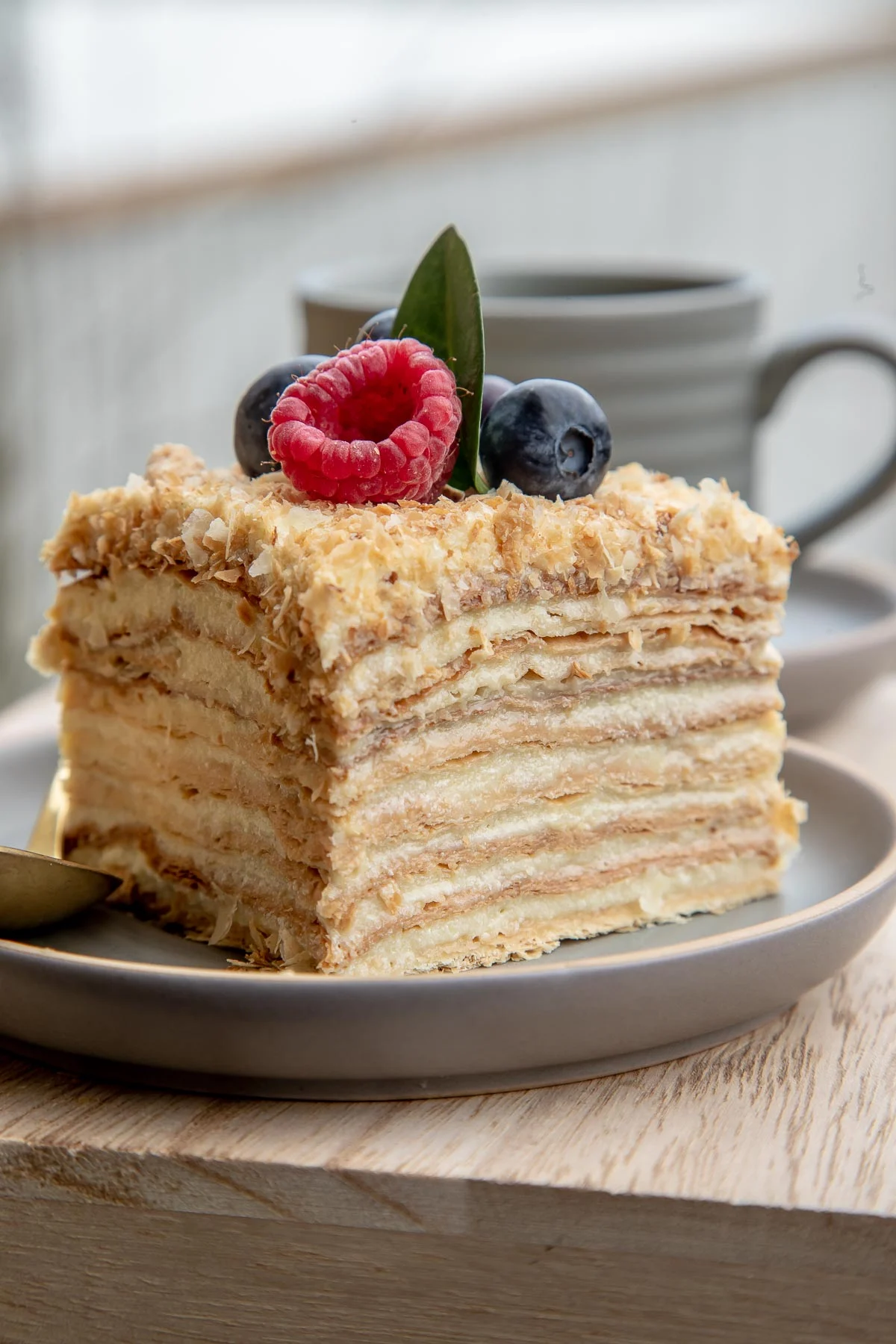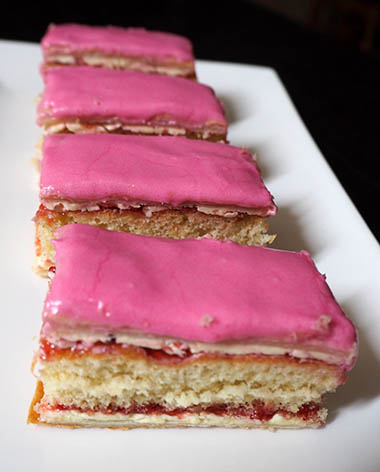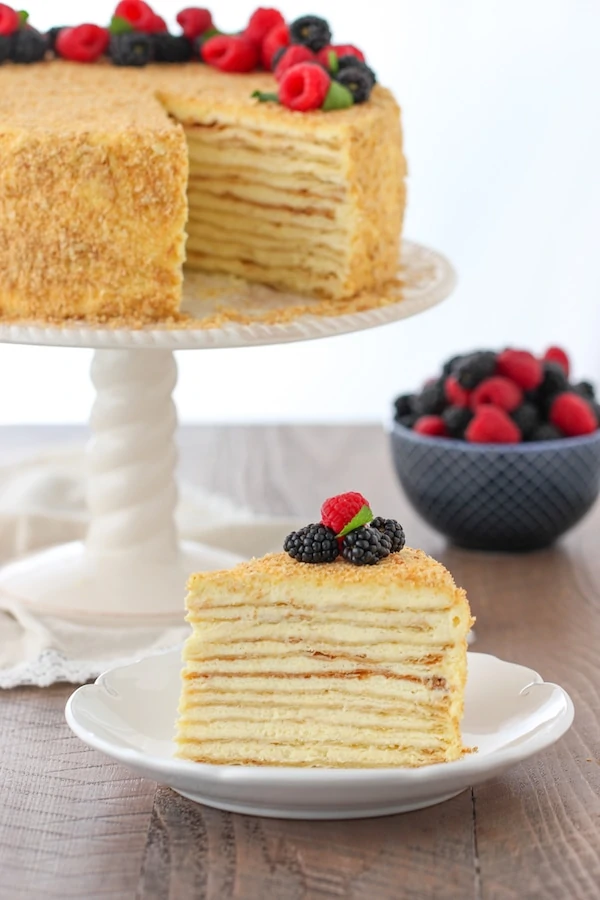Napoleon cake - layers of meaning
- rosemary
- Jul 14, 2024
- 8 min read
"as each family makes it their own way, you’d be pressed to find two recipes that agree on what makes a perfect one."
Deb Perelman/Smitten Kitchen

You would also be hard put to separate a group of cakes and desserts from each other by their names and their making. The one thing they have in common is layers. I'm looking at dessert here - sweet things, but I should also say that all of these things probably exist in savoury versions. I know for a fact that some do, but am guessing at others.
This version is from a website called Sugar Pursuit, which I'm featuring here because of the number of layers - as many as 20 they say.
This post began with a book - my book group book which I really rather liked and the group mostly didn't. For me it was a book with depth - with layers of meaning - which I concur were not immediately obvious. But layers there were - which is very apposite to the story of this cake. There is a crucial scene in the book, set in 1899 in which a diffident young man, shares pastries in the window of a café with a young Russian woman with whom he has fallen in love. It's a romantic and poignant scene, but the thing here is the cake which Sophia - the young lady is eating. It's called a Napoleon cake and she explains why it is named for Napoleon:

"All these layers, you see, meant to symbolise the Grande Armée. And this - she raked the cake's surface and crumbs kicked back against her fork - this represents the Russian snow that stalled the French advance, helping to defeat the little Corsican's troops before reaching Moscow." Eley Williams/The Liar's Dictionary
Charming - but is it true? And besides the contrast between the grim reality of Napoleon's army dying in the Russian snow as they retreated, and a truly decadent cake is possibly somewhat gruesome. Which would indeed make it much more likely to be a Russian invention rather than a French one. The French would not be celebrating.

True? Well it seems it is indeed a very famous Russian cake often made to celebrate the New Year, cromprising layers of very thin puff pastry sandwiched with a pastry cream and covered with the crumbs from the pastry slices. According to Deb Perelman (her Russian Napoleon is shown here):
"It was created in 1912, when it was created to honor the 100th anniversary of Russia’s defeat of Napoleon’s invasion — initially it was shaped to resemble his triangular bicorne (hat); the crumbs are said to represent the snow that did the French troops in." Deb Perelman/Smitten Kitchen
So there's at least one reinforcement of the book's story - and Deb Perelman credits a Russian source with the information. However my story was set in 1899 and Napoleon was defeated way back in 1812 when there would have been much more reason to celebrate than in 1899. It seems there are other 'creation stories' and nobody really seems to be sure Which is correct - indeed does it have anything to do with Napoleon at all?
I found a neat summary of possibilities in the Deseret News, but here I shall briefly digress because my internet wandering turned up something, totally unrelated, that was just too interesting not to share.
Deseret? Where's that I thought? Probably America - well yes, sort of:

"The State of Deseret contemporaneously /dɛsiːrɛt/ dess-ee-ret, as recorded in the Deseret Alphabet spelling 𐐔𐐯𐑅𐐨𐑉𐐯𐐻 was a proposed state of the United States, promoted by leaders of the Church of Jesus Christ of Latter-day Saints(LDS Church) who had founded settlements in what is today the state of Utah. A provisional state government operated for nearly two years in 1849–50, but was never recognized by the United States government. The name Deseret derives from the word for "honeybee" in the Book of Mormon." Wikipedia
Who knew? And a Deseret alphabet too!

I can only assume that the Deseret News is a Mormon newspaper. But - just to continue the digression and incidentally connect back into my blog subject - note that "Deseret derives from the word for "honeybee" in the Book of Mormon." Which is an amazing coincidence because I was also going to mention the Russian honey cake which the Melbourne Food and Wine Festival mentioned in this week's newsletter. This particular version was made by Emilia Jackson. Seeing it there in the newsletter, prompted me to go back to the Napoleon cake which I had noted in my potential subjects list. So before I go back to Napoleon, this cake - the honey cake - is indeed another Russian speciality but this time the layers are cake, flavoured with caramelised honey and sour cream. I'm not sure that this one has sour cream in the filling - it looks more like a butter cream. The commonality with the Napoleon cake is the layers, which Deb Perelman describes with respect to her efforts as
"cookie discs — yes, cookies, but a tiny bit bendy so maybe 10 percent on its way to cake already — smelled like a kiss of buttery honey caramel as they exited the oven"

So where was I? Yes - the Deseret News origin stories which actually refer to the French dessert known as a Napoleon the version shown here being from delicious.
1) The traditional zig-zag pattern of white and chocolate icing created atop the pastry looks like a series of N's.

Not very convincing, although this version shown here in which the icing is rather more professionally executed is probably what they are talking about - it is the traditional design - looks nothing like an N however. The other thing to note here is that this particular photograph is labelled as a Mille-feuille (thousand leaves) and indeed the two names seem to be interchangeable for a pastry consisting of three (not a thousand or even many - the tradition is three) layers of thickish puff pastry sandwiched with two layers of crème patissière.

"2) The pastry was invented by a Danish chef and was first served on the occasion of a state visit by the French emperor."
The only other reference to this origin story was from, of all places Bangkok, was not quite the same and was attached to the Napoleon cake and not to the pastry, although they confusingly add mille-feuille to the mix:
"Originally named "mille-feuille", the Napoleon cake was supposedly brought to Russia by the French in the early 19th century." Saffron Kitchen Bangkok
It would have to be the early, early 19th century though wouldn't it? Napoleon was finally defeated in 1812, so his name would not be popular. Although maybe it was to the French.
"3) The pastry was first created by an Italian chef in Naples who named it "napoletano" after his city, and the name was later corrupted to "napoleon" in English." Deseret News

There are a few supporting stories for this idea - Italy that is. Italy has Millefoglie and this is a version that you can buy in Melbourne's own Brunetti. I have to say that it is usually shown with a reference to mille-feuille, although often the filling seems to be in the form of those little balls as shown here. Be that as it may the very earliest recipes for mille-feuille date back to 1651 in France but:

"Some food historians believe the name Napoleon may instead relate to similarities with Italian desserts from the city of Naples. For instance, the Italian dessert sfogliatelle shares characteristics with the millefeuille like layered pastry and creamy filling. This lends credence to the theory that the millefeuille concept predates the French and may have been introduced in Italy." Cadbury Desserts
Well I think they got confused there because sfogliatelle, shown above, are a bit different. Still Neopolitan as we call things associated with Naples does indeed recall layers - as in ice-cream for example.
One last origin story:
"According to Alan Davidson in the Oxford Companion to Food, the invention of the form (but not of the pastry itself) is usually attributed to Szeged, Hungary, where a caramel-coated mille-feuille is called 'Szegediner Torte'." Wikipedia
And others did refer to Hungary too, but I suspect they were referring to Alan Davidson's attribution. However, when I looked for pictures - or indeed recipes - for this torte I found none, but lots for Szegediner goulash. Szeged is a town in Hungary.

One last rather nice thing from my book. When asked what my diffident young man would call the cake he "tried to usher some poetry. He failed. 'A variant on the custard slice.'" which she ponders on for a while before:
"'A certain pragmatism to custard slice,' Sophia said. 'Is that the term for it? When a word just sits there, entirely fitting but somehow flat?" Eley Williams/The Liar's Dictionary
And it's true isn't it? Custard slice, vanilla slice - it just conjurs up a shape or type of pastry and a flavour. Delicious though it is the name does not conjur pup anything other than what it is. Naoleon however - well Napoleon has an almost infinite variety of connections that stretch all the way to Naples. So Napoleon cake and it's most interesting origin story is yet another example of history on a plate.
One last difference to point out between the French mille-feuille or Napoleon and the Russian Napoleon cake:
In the introduction to her recipe for Russian Napoleon Cake the writer of Let the Baking Begin defines the difference:
"Do keep in mind that this is not the French version of the Napoleon where the layers are kept crisp. This is the Russian Napoleon version where the layers are intentionally allowed to become very soft." ... The secret to delicious and moist Napoleon is mainly letting it sit in the fridge or at room temperature until the cake layers have absorbed enough of the frosting to make them soft and moist. Having very thin cake layers helps the cake get there faster."
She also has another recipe which is simply called Napoleon cake (on right), which differs in that the cake is not left as long for the layers to soften, and so the pastry layers are crunchier.
It's a somewhat sensational looking cake - the number of layers is perhaps up to you and they often decorate with berries, but I suspect it's one of those recipes that looks difficult but probably isn't. There are a number of stages, that are probably relatively easy - maybe not the pastry - and take place over several hours or days - but which, because it is one of those recipes done in stages, is completely doable.
So just to finish with a few more options: Napoleon cake from Teacup in the sky which is different because it alternates sponge cake with pastry, and is filled with butter cream and jam and is iced an alarming pink - no reference to snow there. The author claims it as genuinely Russian in origin however - somebody's mother-in-law or similar; Napoleon cake from Olga's Flavor Factory, which is pretty authentic and two 'cheating' versions (and frankly not nearly as delicious looking) from the lady of Natasha's Kitchen, one of which is a No-bake Napoleon Cake and is made with cookies, and condensed milk and Napoleon cake which uses bought puff pastry and contains walnuts somewhere and looks rather more like a mille-feuille. As Deb Pereleman said: "each family makes it their own way".
Another day, another post, a few more things discovered. Maybe next time I'm in Brunetti's I'll try their millefoglie but I suspect I won't be trying to make my own version of Napoleon cake.
POSTSCRIPT
Those years gone by - almost forgot.
2023 - we were out to lunch
2022 - Baklava - a request













Life is full of layers and each adds to the subtle complexity of life. But with cakes just a few layers are an elegant sufficiency. Many more add to a less healthy diet, and worse - as all the recent stats shows that obesity has now overtaken smoking as the biggest cause of death in those over the age of 45.